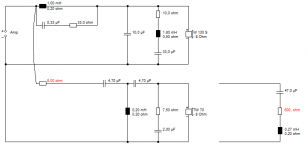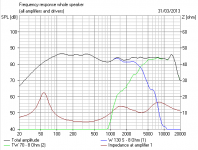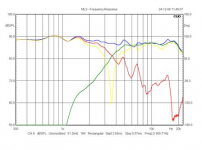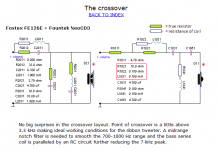Hi guys,
As some of you may know, I'm using Fostex FE126s for midrange and treble duty.
I'll admit that I like loud music from time to time, including things like Marilyn Manson. Those of you that have heard these drivers will know that such music isn't within their "comfort zone". The rising response in the kHz range, coupled with (seemingly) higher distortion up there gives a sound that will rip your ears off quite quickly.
So, I thought about this for a while and came up with a couple of solutions...
- change the Fostex driver for something else
- stop them running past a few kHz, use tweeters.
The extra treble dispersion would be quite nice, so I've opted for the addition of a tweeter.
I started by checking out some of the smaller Dayton tweeters, but found they were all ~90dB sensitivity. I also need a tweeter small enough to fit on my current baffle, giving an absolute maximum of 80mm external diameter.
After a bit of looking around, I found this tweeter:
BC25SC-06/04 - Vifa 1 inch Neodymium textile tweeter - Europe Audio
Zaph seems to like them: Zaph|Audio (you'll need Ctrl+F) and their distortion checks out rather well, even down to around 1.5kHz.
Realistically, I'd like to cross over as low as possible, which would keep dispersion wide (I normally sit quite far off axis), and also stop the rough upper midrange of the Fostex coming through.
I think 2kHz fits the bill quite nicely: if the Fostex datasheet is to be believed, there's a small loss off-axis up there, but nothing much. That crossover point should also keep the tweeter happy.
Anyway.
I went over to Rod Elliott's articles and found one about designing a "proper" passive crossover. Here it is.
I followed this through, and arrived at the crossover below:
In the datasheet, the tweeter shows a fairly sharp impedance spike at resonance. As this is so close to the crossover point, a correction circuit is used to flatten it - the article goes into the effect the peak will have on the crossover, and it ain't pretty.
There's a tweeter L-pad to bring it down to the sensitivity of the Fostex driver.
The rest is the usual caps and inductors for a 2nd order crossover.
However, I decided to take Rod's recommendation for the exact Q of the crossover:
I decided not to bother with a Zobel on the Fostex - the datasheet shows a very minor change in impedance in that frequency range, so I decided that it was safe.
So yes, I've a few days before I can order the parts, so would appreciate any input you guys might have - this is my first attempt at a proper crossover.
Cheers
Chris
PS - if its relevant, the amplifier will be ~120w/ch into 4ohm, with a line-level LR4 crossover at 500Hz, where some woofers take over.
As some of you may know, I'm using Fostex FE126s for midrange and treble duty.
I'll admit that I like loud music from time to time, including things like Marilyn Manson. Those of you that have heard these drivers will know that such music isn't within their "comfort zone". The rising response in the kHz range, coupled with (seemingly) higher distortion up there gives a sound that will rip your ears off quite quickly.
So, I thought about this for a while and came up with a couple of solutions...
- change the Fostex driver for something else
- stop them running past a few kHz, use tweeters.
The extra treble dispersion would be quite nice, so I've opted for the addition of a tweeter.
I started by checking out some of the smaller Dayton tweeters, but found they were all ~90dB sensitivity. I also need a tweeter small enough to fit on my current baffle, giving an absolute maximum of 80mm external diameter.
After a bit of looking around, I found this tweeter:
BC25SC-06/04 - Vifa 1 inch Neodymium textile tweeter - Europe Audio
Zaph seems to like them: Zaph|Audio (you'll need Ctrl+F) and their distortion checks out rather well, even down to around 1.5kHz.
Realistically, I'd like to cross over as low as possible, which would keep dispersion wide (I normally sit quite far off axis), and also stop the rough upper midrange of the Fostex coming through.
I think 2kHz fits the bill quite nicely: if the Fostex datasheet is to be believed, there's a small loss off-axis up there, but nothing much. That crossover point should also keep the tweeter happy.
Anyway.
I went over to Rod Elliott's articles and found one about designing a "proper" passive crossover. Here it is.
I followed this through, and arrived at the crossover below:
An externally hosted image should be here but it was not working when we last tested it.
In the datasheet, the tweeter shows a fairly sharp impedance spike at resonance. As this is so close to the crossover point, a correction circuit is used to flatten it - the article goes into the effect the peak will have on the crossover, and it ain't pretty.
There's a tweeter L-pad to bring it down to the sensitivity of the Fostex driver.
The rest is the usual caps and inductors for a 2nd order crossover.
However, I decided to take Rod's recommendation for the exact Q of the crossover:
Again, this is a world of compromise. My preference is for a sub-Bessel alignment with a Q of 0.5, since it provides a close approximation to a Linkwitz-Riley alignment, and has zero peak or dip at the crossover frequency. Since the Q is lower, it is also marginally less sensitive to variations in loudspeaker driver impedance, but this is not something that should be relied upon.
I decided not to bother with a Zobel on the Fostex - the datasheet shows a very minor change in impedance in that frequency range, so I decided that it was safe.
So yes, I've a few days before I can order the parts, so would appreciate any input you guys might have - this is my first attempt at a proper crossover.
Cheers
Chris
PS - if its relevant, the amplifier will be ~120w/ch into 4ohm, with a line-level LR4 crossover at 500Hz, where some woofers take over.
Brace yourself, Chris. Not much of this makes sense to me, really!
Your Fs resonance correction is at the right 1.4kHz frequency though the resistor is too big at 2.8R. But that little Vifa 4 ohm cheapie tweeter is never going to work at 2kHz crossover. 🙂
I found a Troels project using your FE126E+ Fostex driver:
Fostex FE126E +
Troels does a rather good job equalising the Fostex. Why reinvent the wheel?
Crosses over at 3.5kHz. That sort of frequency is just your usual 3.3uF and 0.4mH followed by an attenuator making about 8 ohms overall load on a tweeter filter, since I don't suppose you'll be using his magnaplanar tweeter. I'd prefer to do this sort of thing with an 8 ohm tweeter rather than a 4 ohm one, but I'd forsee a bit of fiddling around with resistors on the tweeter for level.
Your Fs resonance correction is at the right 1.4kHz frequency though the resistor is too big at 2.8R. But that little Vifa 4 ohm cheapie tweeter is never going to work at 2kHz crossover. 🙂
I found a Troels project using your FE126E+ Fostex driver:
Fostex FE126E +
Troels does a rather good job equalising the Fostex. Why reinvent the wheel?
Crosses over at 3.5kHz. That sort of frequency is just your usual 3.3uF and 0.4mH followed by an attenuator making about 8 ohms overall load on a tweeter filter, since I don't suppose you'll be using his magnaplanar tweeter. I'd prefer to do this sort of thing with an 8 ohm tweeter rather than a 4 ohm one, but I'd forsee a bit of fiddling around with resistors on the tweeter for level.
I think 2kHz fits the bill quite nicely: if the Fostex datasheet is to be believed, there's a small loss off-axis up there, but nothing much. That crossover point should also keep the tweeter happy.
Vifa BC25SC-06/04With a 6dB/octave filter, I suggest an absolute minimum of about 1.5 octaves between the driver resonance and crossover frequency. A tweeter with a 900Hz resonance should therefore be crossed over at a minimum of 2,500Hz, but preferably higher. If you use the minimum possible frequency separation, there will be a small peak at tweeter resonance - this is a combination of the tweeter's resonance itself, and the fact that the crossover cannot maintain the correct rolloff if the load impedance changes.
Rod Elliott - 3.1.2 Midrange and Tweeter Drivers
fs=1390Hz, one and half octaves is 2780(1.octave)+1390 1/2 5560(2.octave) = 4170Hz
Octave bands | APMR
Crossover frequency is very low considering the resonant frequency of the tweeter. Look at the use of the Fostex by others like Troels.
Fostex FE126E +
If the Fostex is 8ohm why you are using a 4ohm tweeter.
It would help if you were using frd/zma's of the drivers in a simulator.
I'd try to not use an electrolytic.
If you must, then be sure to bypass it with the largest value film cap you can muster - the total value being what you need/want.
Finally, you have to listen and measure... on paper it might be wonderful, but until you listen and look at the resulting curve there is no real way to know what you actually are getting.
_-_-
If you must, then be sure to bypass it with the largest value film cap you can muster - the total value being what you need/want.
Finally, you have to listen and measure... on paper it might be wonderful, but until you listen and look at the resulting curve there is no real way to know what you actually are getting.
_-_-
Troels does a rather good job equalising the Fostex. Why reinvent the wheel?
I don't trust the Fostex driver with frequencies that high (he also uses tweeters that are £66 a pop).
The crossover for the tweeter is low, yes, but the thermal power handling test that Vifa put on the datasheet indicates a 1.3kHz 2nd order filter, and the driver will stand 25w doing that (which is more than enough). Zaph's measurements show low distortion to 2kHz, with a bit of a rise below that. I really don't see much of a problem, so long as the tweeter resonance is suitably suppressed.
Which resistor value should I use instead of 2R8?
Inductor,
Note that the article states a 1.5 octave rule for 1st order filters. I'm going 2nd order.
I see no problem with using a 4ohm tweeter - the amplifier will play into 4ohm happily.
I have, however, eliminated the parallel resistor of the L-pad, and re-done the crossover values for a 3.8ohm load. The parallel resistor was only going to waste power by pulling more current through the rest of the components.
I suppose I could try a 2.5kHz filter, but I'd definitely like to keep below 3kHz.
Thanks for the help so far
Chris
Have you ever tried Passive Crossover Designer? It's not too difficult to learn, and can be quite helpful. Hopefully you have measurement tools, but if not you can use SPL tracer to get the measurement files from published measurements. SPL tracer isn't perfect, and you won't have any phase information. It's still a good learning experience, and can help you get a start...
Have you ever tried Passive Crossover Designer? It's not too difficult to learn, and can be quite helpful. Hopefully you have measurement tools, but if not you can use SPL tracer to get the measurement files from published measurements. SPL tracer isn't perfect, and you won't have any phase information. It's still a good learning experience, and can help you get a start...
I've downloaded it, but there's a problem: my laptop came bundled with MS Office Starter. The Excel program included doesn't allow the use of macros, so I can't run the spreadsheet.
The SPL tracer link doesn't go to anything audio-related.
I also have no measurement tools. I have a 31-band graphic eq that I'm using to tame some room issues, but I'm reliant on my ears for this one.
One day I'll get myself some measurement equipment, but I'm on a student budget so the measurement stuff will probably have to wait for a while.
Chris
Don't take that to the letter.Inductor,
Note that the article states a 1.5 octave rule for 1st order filters. I'm going 2nd order.
Sorry to say, but your design approach doesn't look appropriate. I would be losing my time here.
If you are not using a xover simulator or a Spice software you have no idea of what you are doing. Impedance peaks can be very tricky. You want to stay away from those resonance frequencies at the crossover band. A RLC would be a last resource to fix a good (bad) design, not a design feature to start width i.e. handicap. 😉
I found this tweeter:
BC25SC-06/04 - Vifa 1 inch Neodymium textile tweeter - Europe Audio
Zaph seems to like them
probably get the good scores because its cheap, which makes it a contender in the 'value group'
doesnt't really mean its good
only that it may have 'potential' for the very low cost designs
which happens to be one of his 'domains'
and I suppose Zaph could make it work ok, with a lot of work and care
but without skills/experience/measurements .... 😱
I'll admit that I like loud music from time to time, including things like Marilyn Manson.
So, I thought about this for a while and came up with a couple of solutions...
- change the Fostex driver for something else
- stop them running past a few kHz, use tweeters.
ahh, I see
you need a tougher midrange with bigger voice coil if you want to play loud without distortion
I always enjoy simming Troels' circuits. He's SO CLEVER! 😎
Fostex FE126E +
I found his bass circuit to be a work of genius. The 8kHz tank takes out some Fostex peaks. The 650Hz notch takes out a nasty 1kHz bump.
The tweeter needs 3rd order for any sort of phase alignment and the Zobel helps, being equivalent to Troels' tweeter RL circuit, but cheaper. A Fs resonance circuit with 2.8R in it, will do nice things to the TW70 tweeter (which happens to be Fs 1.4kHz...) I used here. But with a third order at 3.5kHz just isn't necessary. Anyway it produces time alignment and phase problems, so out it goes. Bye! 😀
I'd suggest you use Troels bass circuit and my tweeter circuit with the cheapie Visaton TW70 Cone tweeter.
The 8 ohm input resistor to the tweeter circuit is your level adjust. It's a complex and expensive crossover, but should be very good. Stripping elements out made it a lot worse. I show it placed against a wall, because that seems a good thing with this Fostex driver, which doesn't like big bass excursion.
Fostex FE126E +
I found his bass circuit to be a work of genius. The 8kHz tank takes out some Fostex peaks. The 650Hz notch takes out a nasty 1kHz bump.
The tweeter needs 3rd order for any sort of phase alignment and the Zobel helps, being equivalent to Troels' tweeter RL circuit, but cheaper. A Fs resonance circuit with 2.8R in it, will do nice things to the TW70 tweeter (which happens to be Fs 1.4kHz...) I used here. But with a third order at 3.5kHz just isn't necessary. Anyway it produces time alignment and phase problems, so out it goes. Bye! 😀
I'd suggest you use Troels bass circuit and my tweeter circuit with the cheapie Visaton TW70 Cone tweeter.
The 8 ohm input resistor to the tweeter circuit is your level adjust. It's a complex and expensive crossover, but should be very good. Stripping elements out made it a lot worse. I show it placed against a wall, because that seems a good thing with this Fostex driver, which doesn't like big bass excursion.
Attachments
So I downloaded BoxSim and then started looking for Visaton drivers with similar characteristics to those I'm trying to use.
This tweeter has a similar impedance spike and LF rolloff to the Vifa.
The W100S has a peaky upper midrange similar to that of the Fostex.
I've been playing around with those in Boxsim, and I'll post some graphs up later. Initial results are looking good.
Chris
PS - BSC isn't an issue, I have woofers doing 500Hz and below.
This tweeter has a similar impedance spike and LF rolloff to the Vifa.
The W100S has a peaky upper midrange similar to that of the Fostex.
I've been playing around with those in Boxsim, and I'll post some graphs up later. Initial results are looking good.
Chris
PS - BSC isn't an issue, I have woofers doing 500Hz and below.
I always notice that working full-rangers into two-ways is just like using a conventional reed or metal cone in the end! All those notches.
You might just do the simple thing and build a conventional two-way. It'll be cheaper! 😀
http://www.diyaudio.com/forums/multi-way/27969-series-crossover-15.html#post3423469
You might just do the simple thing and build a conventional two-way. It'll be cheaper! 😀
An externally hosted image should be here but it was not working when we last tested it.
http://www.diyaudio.com/forums/multi-way/27969-series-crossover-15.html#post3423469
I always notice that working full-rangers into two-ways is just like using a conventional reed or metal cone in the end! All those notches.
You might just do the simple thing and build a conventional two-way. It'll be cheaper! 😀
http://www.diyaudio.com/forums/multi-way/27969-series-crossover-15.html#post3423469
I like these Fostexes. They just need help at both ends.
.. and in the middle.
This is gonna become a small 3-way when I'm done. TB W6-1139s for bass, Fostex FE126eNs for mid, and a tweeter for treble.
2-ways aren't quite enough IMO - if the mid will meet the tweeter, it'll need some help in the bass.
(I also have a 12" subwoofer under the bed for movies - its great 😀 )
I had forgotten all about BoxSim, so thanks for that prompt. I'll have a play around over the next few days and see where I end up. Something tells me I'm going to need steeper crossovers for the Fostex.
Cheers
Chris
The SPL tracer link doesn't go to anything audio-related.
Chris
hmm... try this one: FRD Consortium. Then look for SPL trace.
not that it's much help though if you can't get Passive Crossover Designer to work...
hmm... try this one: FRD Consortium. Then look for SPL trace.
not that it's much help though if you can't get Passive Crossover Designer to work...
Found it in the end, though I'm struggling to get it to work nicely - I try to save the files, but no matter what I do it creates a file of 0 bytes, and the Viewer says it won't load.
I suspect an ID-ten-T error on my part, and will look into it tomorrow.
BoxSim accepts the driver files, and has all the simulating capability I need. With a bit of luck I'll be able to bring the two together.
If not, the woofer I linked earlier has a similarly nasty upper midrange to the Fostex, so if I make that usable, the Fostex should fall into line.
Cheers
Chris
This passive solution is complicated and I don't think you'll end with anything any good especially only with two pole filters. Go active it will sound better than anything you could do passive and its easier.
I think Chris has put his finger on it saying the Fostex needs some help in the bass and at the top. 😎
Everything about is has the attributes of a Midrange speaker, which is the range where it is good. Low mass, low inductance, underhung voice coil that dislikes big excursion.
Not far away from the SEAS MCA12RC Midrange.
It's the sort of thing that would go into a good 3-way.
But I like the idea of adding a cone tweeter just to improve the dispersion. It's gotta be better. 😀
Everything about is has the attributes of a Midrange speaker, which is the range where it is good. Low mass, low inductance, underhung voice coil that dislikes big excursion.
Not far away from the SEAS MCA12RC Midrange.
It's the sort of thing that would go into a good 3-way.
But I like the idea of adding a cone tweeter just to improve the dispersion. It's gotta be better. 😀
You would be far better off using a driver with half decent excursion (for dynamics and low distortion). Crossed about 150Hz to the sub and at about 2-2.5KHz to a good tweeter - all active of course! This combination in my opinion is the best configuration when done correctly and will beat any other speaker.
- Status
- Not open for further replies.
- Home
- Loudspeakers
- Multi-Way
- Can someone check this crossover design for me?



